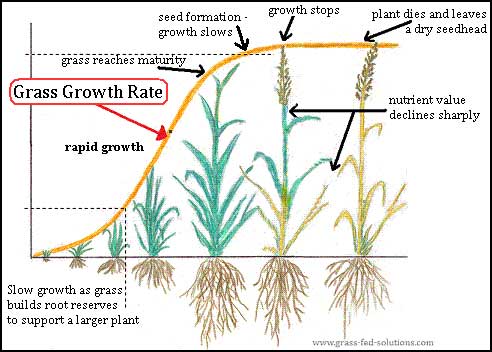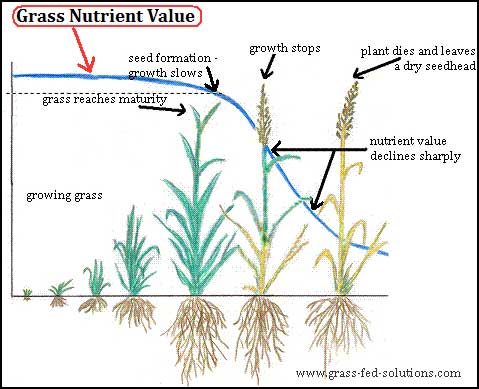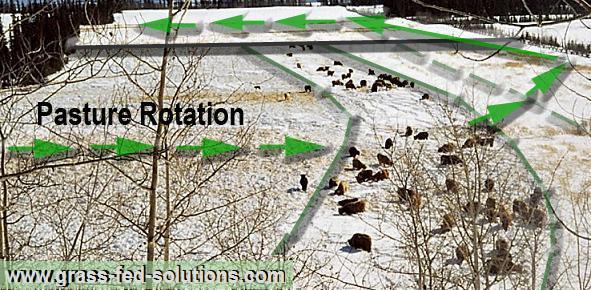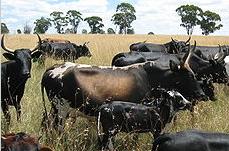The Seven Core Rules
of Successful Grazing Management
There are seven core grazing management rules guiding the rotational grazing strategies at the heart of all successful grass-fed beef production.
If you produce grass-fed beef, you should commit these grazing rules to heart. They should influence every decision that you make as you set up and manage your grazing business.
Follow the links or click on the images beside each Grazing Rule to read the full articles. This summary of the grazing rules is meant as a quick refresher to help you as you work on your grazing management plan.
Grazing Rule #1:
Always use DAILY grazing slices, all year round.
|
Daily pasture moves alter the behavior of your grazing herd. |
|
The fine control you have over your grazing herd when you use daily pasture moves makes all the remaining grazing management rules possible.
Grazing Rule #2:
During the growing season, your grazing rotation should speed up or slow down in order to prevent the grass from reaching maturity and going to seed.
|
This grazing management rule means that sometimes pastures will only be grazed very lightly (a quick top-grazing) while they are growing very quickly so that the grazing rotation can keep up with the rapidly maturing grass. But then as grass growth slows during the mid-summer heat or towards the tail end of the growing season, you'll need to slow down your rotational grazing. Just remember to always leave at least a 6-10 inch grass stubble! |
|
Additional benefit of a tall grass stubble: Leaving a tall grass stubble after grazing helps to reduce moisture evaporation from the soil by keeping the soil shaded, which in turn will benefit your grass growth.
Grazing Rule #3:
While grazing during the growing season, NEVER leave less than a 6 - 10 inch stubble so you can maximize grass growth and reduce soil moisture evaporation.
|
Leaving a minimum of a 6-10 inch stubble helps maintain a large root mass that can support rapid grass growth and ensures that the stubble is tall enough to provide shade for the soil, which reduces soil moisture evaporation. |
|
Additional benefit of a tall grass stubble: Since the root mass mirrors the green leafy material above ground, leaving a tall grazing stubble also ensures that the plant retains longer roots that are able to draw both nutrients and moisture from deeper in the soil. This reduces fertilizer costs, increases grass quality, and leaves your pasture more drought-resistant after grazing.
Grazing Rule #4:
If you start running out of pasture during the growing season, it is better to feed a little hay to let your pastures catch up than to graze shorter than 6-10 inches.
|
If you start running short of grass during the growing season, it is much better to feed a little hay than to start grazing the pastures too short. This grazing management strategy ensures that you to keep your grass within its optimal band of maximum growing speed so that the pastures will produce far more volume of grass during the growing season. |
|
If you graze shorter than a 6-10 inch stubble in order to maintain your pasture rotation, the extra grass you gain in the short-term by grazing the pasture to the ground will be more than lost later because the grass growth will be so very much slower after grazing.
Additional consideration: Grazing shorter than 6-10 inches during the growing season also reduces the ground water that the plant can access for growth. Short roots can't reach as deep. And a short stubble won't shade the soil. Feeding a bit of hay to tide you through a dry spell so you can leave a taller grass stubble means that your pastures will resume growth much sooner after the dry spell.
A tall grass stubble is also your most powerful drought protection strategy because it reduces moisture evaporation and ensures that the grass can resume growing again sooner, with less rainfall, than if you graze too short. Feeding a bit of hay from your emergency hay reserves is therefore your first line of defense towards reducing the severity and duration of any drought.
Grazing Rule #5:
Pasture is much cheaper than stored feed. The longer you can graze your cattle after the end of the growing season, the lower your beef production costs will be.
|
Adjust your beef production system to replace expensive feed with cheap pasture by extending your grazing season long after the growing season ends. |
|
The secret to being profitable in the grass-fed beef business is following this grazing management rule.
Grazing Rule #6:
Use your summer grazing rotation to prepare your pastures for winter grazing.
|
Tall, high-quality pasture that has been prevented from going to seed by your summer's intensive grazing management will require the least supplementation, will entice your cattle to graze longer, and will stand up best to the ravages of wind, rain and snow. |
|
Grazing Rule #7:
During the winter, ration out your 'crop' of winter pastures using small daily slices of pasture.
|
Plan the 'flow' of your winter herd migration in advance so you can time the grazing sequence of your winter pastures according to the requirements of your winter livestock water system.
Pre-planning the 'flow' of your winter grazing season also allows you to prepare for the weather conditions you expect throughout the winter season, account for differences in snow pack around your farm, and protect vulnerable pastures against damage from trampling hooves during muddy seasons. |
|
Addendum: Your grazing management rules will only be effective if you have also prepared your cattle so they can thrive in a grass-based production system.
|
|
- Body fat is the way that your cattle store cheap summer pasture so they can supplement their winter pasture nutrition and safely extend the winter grazing season.
- Restricting the length of your breeding season to 42 days is vital to matching your cattle's growth stages and year-round nutritional requirements to the environmental challenges and changes in the nutritional quality of your pastures over the course of the seasons. It is also the only way that beef producers in northern climates can expect to grass-finish and slaughter calves before their second winter.
- Breed choice, the genetic selection of individual breeding stock, and culling cattle with poor fertility or high-maintenance characteristics are three additional crucial principles that are required to prepare your cattle for your grazing environment and production system.
These four additional important grass-fed principles are discussed further in the article about raising beef cattle to thrive in your pasture rotation, which will provide you with an overview of each of these four grass-fed production principles along with links to explore each of these concepts in greater detail.
Related Articles:
(Disclosure: I get commissions for purchases made using Amazon links in my post.) And when you're ready to start planning your cattle farm, check out my book: Grass-Fed Cattle: How to Produce and Market Natural Beef. Use the links below to explore my book and read reviews on Amazon: 
|











